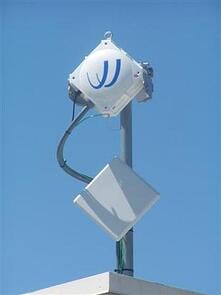The term "Microwave" is a broad term that covers the UHF (Ultra High Frequency with frequencies between 300MHz and 3GHz) to the EHF (Extremely High Frequency with frequencies between 30GHz to 300GHz). Licensed microwave links and unlicensed wireless Ethernet bridges typically operate in the SHF (Super High Frequency with frequencies between 3GHz to 30GHz) and the EHF bands.

A general rule of thumb is that lower the frequency the farther the signal will travel. Also lower frequencies the lower the throughput and higher the frequency the higher the throughput. Again this is in general terms and depends on the wireless radio hardware used.
The terms "unlicensed wireless bridge" and "licensed microwave link" refer to the radio frequency spectrum characteristics set by the U.S. Federal Communications Commission ("FCC") or equivalent national government regulatory body. Licensed products require regulatory approval before deployment while license-exempt products can be deployed without any regulatory approval.
Licensed microwave link frequencies used for wireless backhaul in a point to point wireless backhaul operate 6GHz, 11GHz, 18GHz, 23GHz bands and the 80GHz millimeter wave E-band. Unlicensed wireless Ethernet bridges, used in point to point wireless bridges, point to multipoint wireless bridges, or wireless mesh configurations, typically operate in 900MHz, 2.4GHz, 5.3GHz, 5.4GHz, or 5.8GHz frequencies. There is also the 60GHz millimeter wave band that is used for point to point gigabit wireless bridges.
There are registered frequencies that many think are licensed but are actually unlicensed, like the 3.65GHz WiMax band used for point to multipoint wireless backhaul and the 4.9GHz Public Safety band. These registered bands do provide some protection against interference but only require local users to coordinate with one another on frequency channel coordination. This is often confused by Public Safety organizations that think the 4.9GHz band is for exclusive use by local law enforcement. Anyone can register the use of the 4.9GHz band as long as it's used for some form of public safety, such as video backhaul. Licensed microwave wireless radio systems are typically built and designed for long term solutions. Point to point licensed microwave links are true fiber replacement systems and offer full duplex wireless communications for both Ethernet and TDM. The licensed wireless bridge hardware is designed to provide carrier grade performance (high bandwidth and low latency). Because a microwave link is licensed and is not to inject and interference on other licensed microwave backhaul operators in the area they must have LOS (line of sight) and not cause heavy multipath. This is a common question of why licensed microwave radios don't use OFDM or MIMO and why they can't be used in NLOS (non line of sight) applications. In a NLOS wireless link application unlicensed wireless backhaul radios that use OFDM or MIMO take advantage of multipath for their connectivity.
Licensed microwave wireless radio systems are typically built and designed for long term solutions. Point to point licensed microwave links are true fiber replacement systems and offer full duplex wireless communications for both Ethernet and TDM. The licensed wireless bridge hardware is designed to provide carrier grade performance (high bandwidth and low latency). Because a microwave link is licensed and is not to inject and interference on other licensed microwave backhaul operators in the area they must have LOS (line of sight) and not cause heavy multipath. This is a common question of why licensed microwave radios don't use OFDM or MIMO and why they can't be used in NLOS (non line of sight) applications. In a NLOS wireless link application unlicensed wireless backhaul radios that use OFDM or MIMO take advantage of multipath for their connectivity.
Microwave communication using unlicensed wireless Ethernet bridge systems have been an extremely popular choice for outdoor wireless backhaul. The unlicensed spectrum of 5GHz (5.3GHz, 5.4GHz, and 5.8GHz UNII bands) became a primary selection by many end users and outdoor wireless installation VAR's, because of their flexibility, cost effectiveness, rapid ROI, and quick deployments. Many outdoor wireless manufactures started introducing "value line" point to point wireless Ethernet bridges using 802.11 chipsets. Basically, the same radio boards found in Wi-Fi access points put into an outdoor enclosure and using outdoor wireless antennas. The new 802.11n based wireless backhaul radios use OFDM and MIMO taking advantage of multipath, especially helpful in NLOS (non line of sight) applications. The major issue with unlicensed wireless Ethernet bridges is potential wireless interference.





